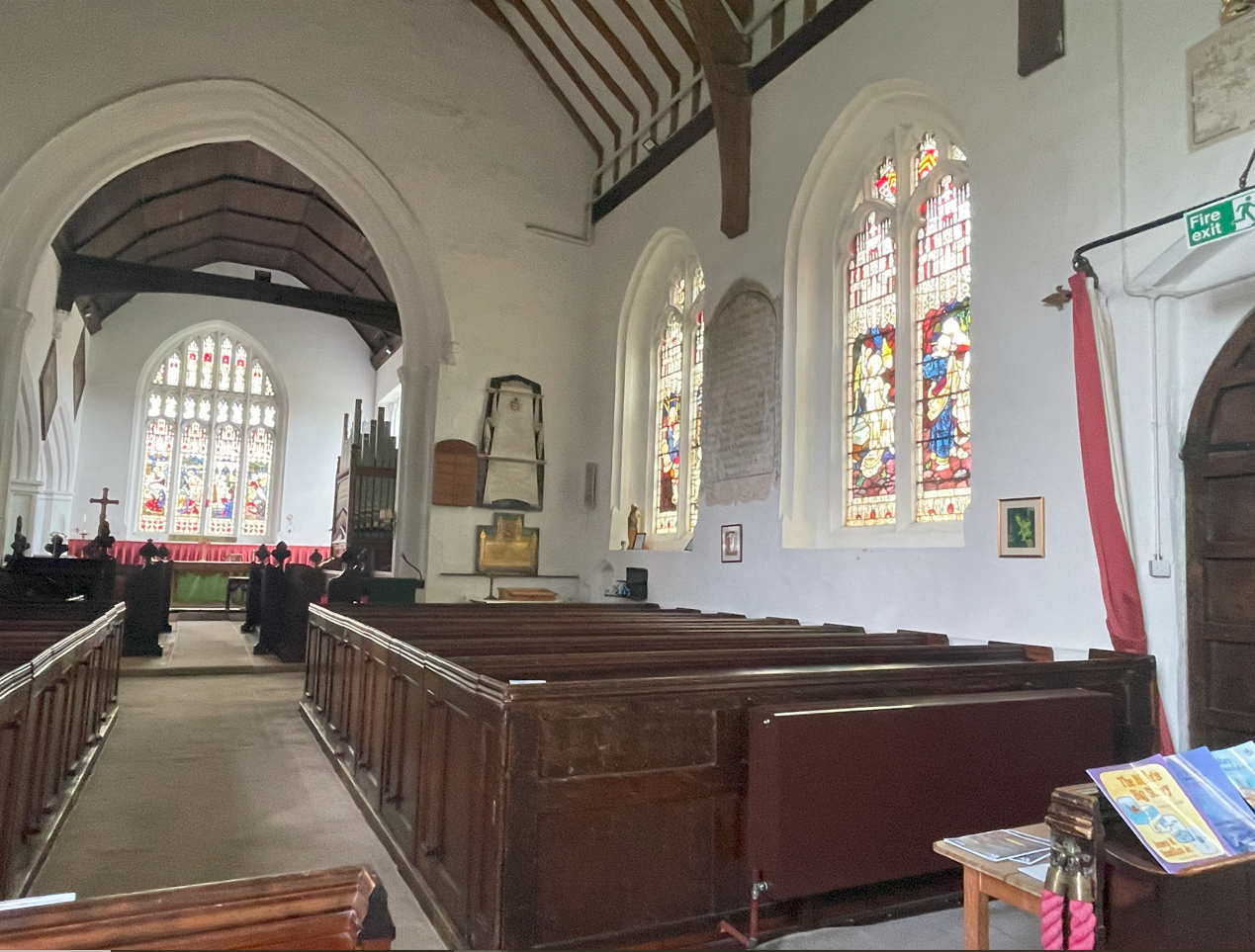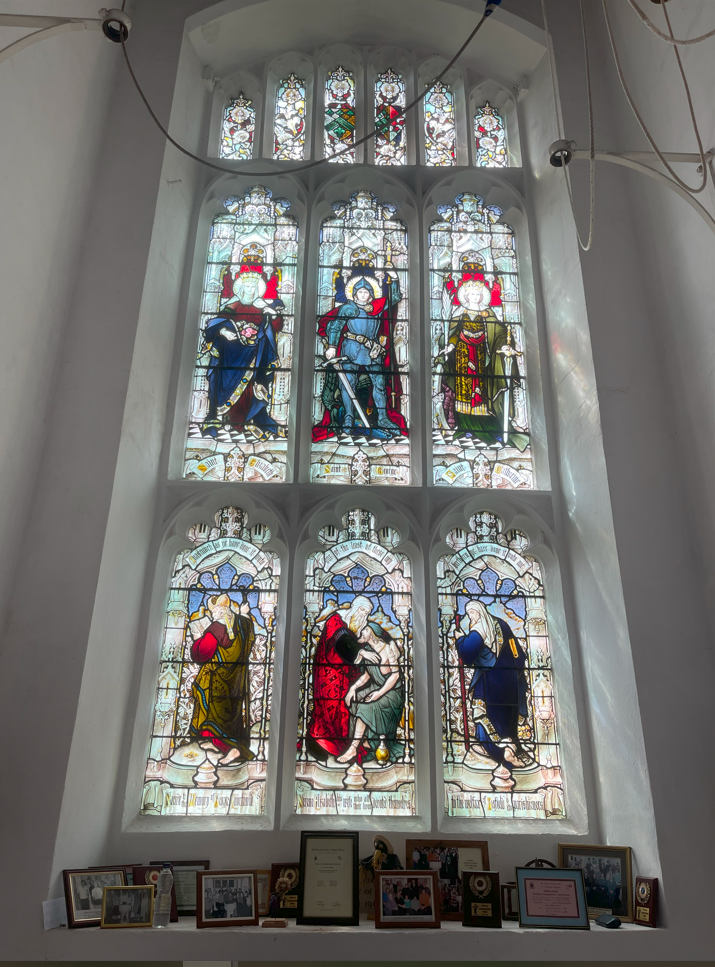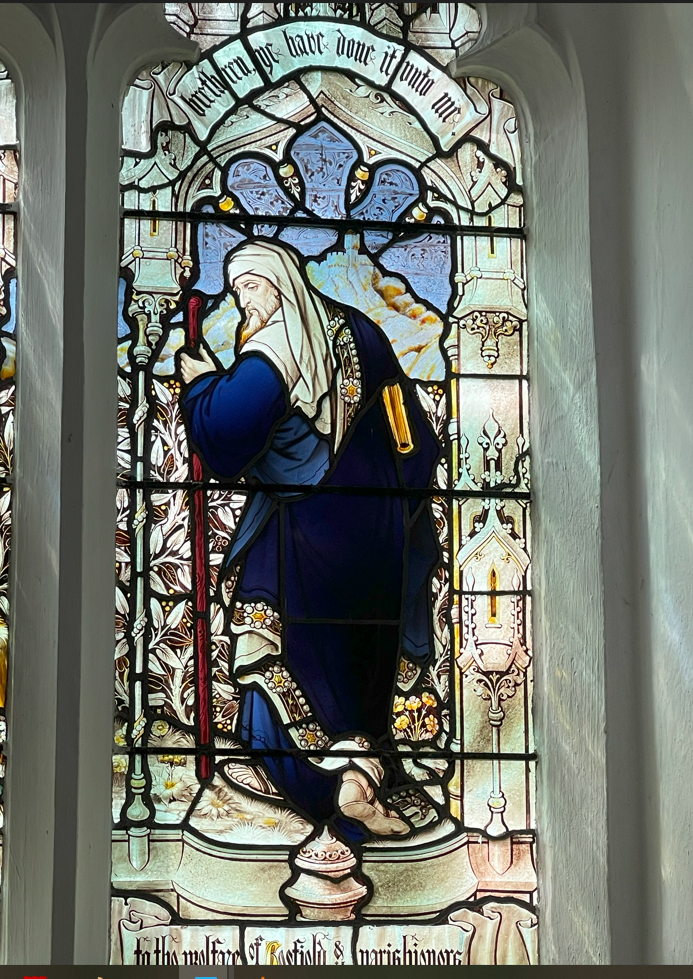Gosfield St. Catherine's
Visited 17th July 2023.
Gosfield is a village that features prominantly in Belchamp Walter's past. Sir Roger Wentworth owned Belchamp Manor and his Grandson John sold the estate to John Raymond in 1611.
There is also a memorial to the Sparrow family in the church and I have (possibly) conflicting reearch on what the connection to Belchamp Walter is. The Sparrow family is associated with Gestingthorpe and a Raymond married an Anne Sparrow. It is not known if this was a Sparrow from Gestingthorpe or Gosfield. The Sparrows were residents of Gosfield Place before it was demolished in 1924.
The church was founded by Thomas Rolfe whose daughter and co-heiress of Editha Helion is buried in St. Catherine's. Editha Helion was Edith Greene before she married John Helion.

The site of Gosfield Place is SE of Gosfield, Essex half way between Sparrows Pond and Little Aldercar Wood. The park was designed by Humphry Repton in 1811. Gosfield Place was built as a Georgian classical house in 1800 then rebuilt in 1865 as a larger French influenced house. It was demolished 1924-5.
The Church of England listing
The achurchnearyou.com website has more information about the church than the official church website - stcatherineschurchgosfield.org.uk
The Building of the church
The first church was built in 1190 by Aubrey de Vere, 3rd Earl of Oxford, the owner of Hedingham Castle
and a great landowner in
the area. His wife had recently established a convent in Hedingham, and the right to appoint a vicar was
given to the nunnery.
When Henry VIII suppressed the Convent in 1536, the rights were given to the Earl of Oxford, and later to
the owners of Gosfield Hall,
who finally ceded their rights at the end of the 20th century.
As you approach Gosfield Church through the lych gate, a silver star can be seen, painted on the corner
buttress. It is the de Vere
star or mullet of the Earls of Oxford. When the buttress was rebuilt in 1560, the 16th Earl of Oxford has
just paid for a new roof
to the chancel, and as a compliment to him his star was placed on the corner which faces towards Hedingham.
So the connection between
the de Veres, Hedingham and Gosfield is remembered.
There is no record of what that first church looked like. There is no written description and no foundations
have been found, so we have no indications of the size and appearance of the building. It was almost
certainly built out of lime mortar and any pebbles,
roman tiles, and flints which were available, there being no building stone in Essex. It probably had a
thatched roof. The church was almost certainly smaller than the present church because by the 1400s it was recorded that Gosfield was ‘a great town with 240 housing people (i.e. communicants).
So in 1435 Sir Thomas and Lady Anne Rolfe built a new church. We know what it looked like, for today the
main body of the church is much as it was then. We even know what the founder looked like because his brass is on his tomb to the right of the main altar.
The brass (1440) shows Rolf in his robes as a Serjeant-at-law, a title which now survives in the Common
Serjeant of the City of London.
It is the only brass figure of a Serjeant in Essex and one of only 5 in England. His wife was
Anne Hawkswood descended from
Sir John Hawkwood of Sible Hedingham, a famous mercenary soldier whose memorial is in the cathedral in
Florence.
Thomas Rolf and his wife Anne Hawkwood also have their coats of arms on either side of the nave side of
the chancel arch.
The one on the left is for Rolf and the other on the right for Hawkwood.
Much of Rolf’s church still survives - the Nave, the East Window and the main door. The stained glass
windows have disappeared,
except for some fragments which were put together in the north window of the nave. No doubt the rubble from
the original church was incorporated in the new church.
The Rolfs had only one child, Editha. The brass to her second husband John Greene (1473) has gone but the
shape of it can be
clearly seen in the nave. Editha may have been responsible for the building of the church tower in about
1490 as a climax of her
father’s building. Most village churches were first built without towers, with timber turrets occupying a
western bay holding a
single bell. The base of this turret can still be seen. It is the beam which spans the church at the
west end.
In the churchyard there are a few interesting items. The Lych gate was built in 1919 and has inscribed
the words in Latin
‘Mors Annua Vitae’ which means ‘Death is the gateway to life.’ This recalls the function of a lych gate
as a place where corpses
lay before being brought into church.
On the north wall are tombs to the Courtauld family. The great silk weaver Samuel Courtauld bought
Gosfield Hall in the late
19th century and was a major employer in the area. One of his ancestors Louisa Perrin Courtauld has
tomb not far from the wall.
Her body was removed in an exhumation and forensic analysis of bodies for a church in Spitalfields,
London where the
Courtauld family originated. Her body was re-interred here.
To the north west of the tower is a memorial to the Poor Clare nuns with an explanation board.
They were nuns who fled to
Gosfield with their priest during the French Revolution. They lived in Church Road in a house now called
Highgates, and the
nearby road called Nuns Meadow is named after them.
If you look across the field to the North West you will see Gosfield Hall. The field is all that remains
of a landscaped park
and still contains specimen trees such as Wellingtonias. The Hall had its own path leading to the church.
The Organ
The organ single manual with 6 stops made by Hill & Co in 1877. Although small it has a fine tone.
Church Silver
The church possesses a fine collection of silver comprising a paten, two chalices and a flagon. Sir Thomas
Millington,
owner of Gosfield Hall presented them to the church in 1704. Unfortunately their value is such that they are
kept in a bank vault and are rarely brought out.
Church Registers
The church registers go back without a break to 1539. All except the most recent are stored in the
Essex Record Office, but there is a
comprehensive record of the graves and memorials in the church and churchyard which is available in the
church for family research.
Gosfield then [1890-1945]
Gosfield in 1890 was a quiet rural village whose inhabitants worked mainly in agriculture and which was dominated by the two great
estates of Gosfield Hall and Gosfield Place.
Samuel Courtauld who had purchased Gosfield Hall had used his great wealth derived from weaving silk, to provide new housing for his
workers, clearing away some old cottages in the process. These new houses are now known as Park Cottages. He also built the Primary
School and the coffee and reading rooms. Meanwhile the Sparrow family of Gosfield Place also built a new school. [The front part of the present Rowson Hall]
Little changed before the Second World War except the decline in agriculture forced many of the people to look for employment elsewhere in the Courtauld factories in Halstead, Bocking and Braintree, and the Crittall factory in Braintree. The arrival of the bus services in the village was another factor in the process.
Electricity began to arrive in the village in the 1930’s but water supply and sewerage were still very primitive, some depending on private water suppliers, others still using own wells. In the depression of the 1930’s there was a great deal of rural squalor with some houses being virtually uninhabitable– Ropers Row on the corner of Hedingham road and Halstead road being a good example.
The second World War brought great changes. House building and repairs stopped for six years, Gosfield Hall
fell into disrepair, and after 1941, the Americans arrived to build and operate Gosfield aerodrome.
Convoys of troops passed through the village, sometimes being billeted on the playing field, and the
young men of the village volunteered to serve their country and ended up in distant parts of the world
Gosfield Since 1945
The twenty years after 1945 were to see a complete transformation in the village. The Parish Council were
desperate to get new housing in the village, As a result, council houses were built at The Limes and The
Cedars in the 1950’s and derelict cottages were knocked down.
Mains drainage and water were also installed in the village in the 1950’s and most people now had
electricity. With the increase in motor traffic, pavements were built for pedestrians.
In 1950 the parish council bought part of the Gosfield Estate as a Playing Field for the village.
Gosfield Hall itself was in such a poor state of repair that it was nearly pulled down. Fortunately,
it was rescued for use as a nursing home, then as rented accommodation for retired people and finally
as a wedding venue.
The 1960’s saw the most dramatic changes with the building of the new estates. Nuns Meadow, Highlands,
Greenfields and the School Park Estate were built at this time, more than doubling the population and
bringing people from all parts of the country. They were a new generation of villager, who commuted
by car to local towns, but could enjoy the tranquillity of village life.
Today, the influx of mostly young married couples in the 1960s has created a demographic imbalance
which can be seen in the Survey. Gosfield has the highest percentage of over 60s in the whole of the
Braintree District.
In recent times new facilities have been built. In 1983 the Maurice Rowson Hall was opened after a
fund-raising campaign by villagers. In 2003 a New Pavilion was built on the Playing Field, and in the
1980’s the old sand and gravel workings were acquired by the village as a Nature Reserve– a much
valued resource for the village.
Slideshow




Note the off-centre East window




